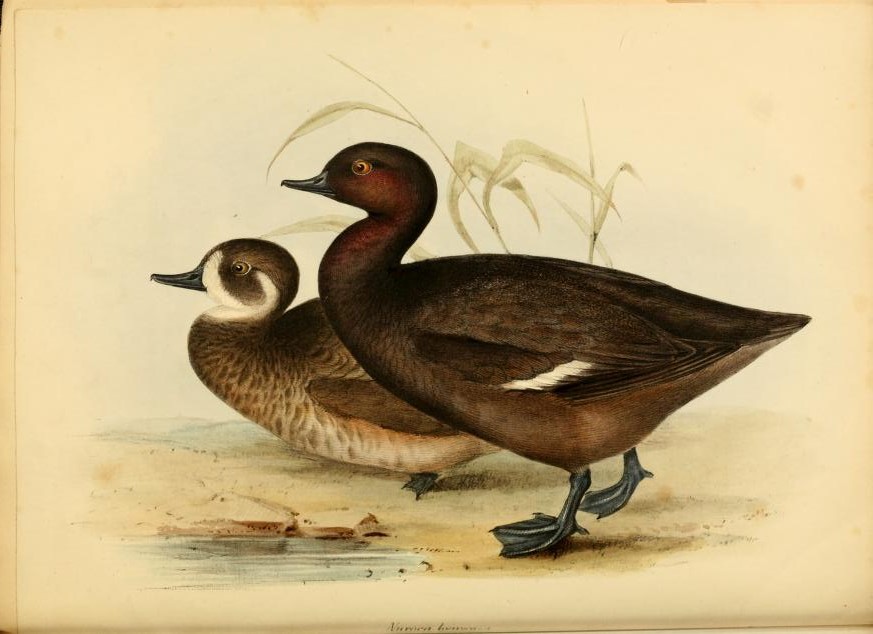Southern pochard on:
[Wikipedia]
[Google]
[Amazon]
The southern pochard (''Netta erythrophthalma'') is a species of
Monogr. Anat., 1838, p.161., pl.23.
, the African Southern Pochard, are held in the vertebrate zoology collections of
Species text in The Atlas of Southern African Birds
duck
Duck is the common name for numerous species of waterfowl in the family Anatidae. Ducks are generally smaller and shorter-necked than swans and geese, which are members of the same family. Divided among several subfamilies, they are a form t ...
, and a member of the genus ''Netta
''Netta'' is a genus of diving ducks. The name is derived from Greek ''Netta'' "duck". Unlike other diving ducks, the ''Netta'' species are reluctant to dive, and feed more like dabbling ducks.
These are gregarious ducks, mainly found on fresh ...
''. There are two subspecies, the South American (southern) pochard ''N. e. erythrophthalma'' (Wied-Neuwied, 1833) and the African (southern) pochard ''N. e. brunnea'' ( Eyton, 1838).
The South American pochard has a fragmented range and is found from Colombia, Venezuela, Brazil, Ecuador, Peru, Bolivia and Argentina to Chile. Here it occurs in a wide variety of shallow fresh waters with submerged vegetation, from the lowlands up to 3,700 metres.
The African pochard occurs from the Cape to the Ethiopian highlands on water bodies with or without emergent vegetation. They are suspected to have been strong migrants in the past but the construction of numerous farm dams seems to allow them a more sedentary lifestyle. They reach highest concentrations in Africa's central plateaus and in the south-western winter rainfall region.
Taxonomy
Two syntype specimens of ''Nyroca brunnea'' EytonMonogr. Anat., 1838, p.161., pl.23.
, the African Southern Pochard, are held in the vertebrate zoology collections of
National Museums Liverpool
National Museums Liverpool, formerly National Museums and Galleries on Merseyside, comprises several museums and art galleries in and around Liverpool, England. All the museums and galleries in the group have free admission. The museum is a non ...
at World Museum
World Museum is a large museum in Liverpool, England which has extensive collections covering archaeology, ethnology and the natural and physical sciences. Special attractions include the Natural History Centre and a planetarium. Entry to the ...
, with accession numbers NML-VZ D832 (male adult) and NML-VZ D832a (female adult). The specimens were collected in South Africa and came to the Liverpool national collection via Thomas Campbell Eyton
Thomas Campbell Eyton JP, DL (10 September 1809 – 25 October 1880) was an English naturalist whose fields were cattle, fishes and birds. He was a friend and correspondent of Charles Darwin though he opposed his theories.
Eyton was born at ...
’s collection and the 13th Earl of Derby
Edward Smith-Stanley, 13th Earl of Derby (21 April 1775 – 30 June 1851), KG, of Knowsley Hall in Lancashire (styled Lord Stanley from 1776 to 1832, known as Baron Stanley of Bickerstaffe from 1832-4), was a politician, peer, landowner, bui ...
’s collection which was bequeathed to the city of Liverpool. There are two other syntype specimens, including NHMUK 1845.7.6.271, in the Natural History Museum at Tring
The Natural History Museum at Tring was the private museum of Lionel Walter, 2nd Baron Rothschild; today it is under the control of the Natural History Museum, London. It houses one of the finest collections of stuffed mammals, birds, reptiles ...
.

Habits
Southern pochards are sociable and gregarious. They have been seen in groups of up to 5,000.Mating and nesting
The birds are solitary nesters, building nests out of leaves and stems on the banks of a river surrounded by vegetation. The female southern pochard lays a clutch consisting of six to fifteen eggs. The female incubates the eggs for 20 to 28 days. Once the eggs hatch, the mother leads them immediately to water.Eating habits
The southern pochard eats mainlyaquatic plant
Aquatic plants are plants that have adapted to living in aquatic environments (saltwater or freshwater). They are also referred to as hydrophytes or macrophytes to distinguish them from algae and other microphytes. A macrophyte is a plant that ...
s, which it finds when diving. The adults also feed on larvae, pupae
A pupa ( la, pupa, "doll"; plural: ''pupae'') is the life stage of some insects undergoing transformation between immature and mature stages. Insects that go through a pupal stage are holometabolous: they go through four distinct stages in their ...
, aquatic animals and plant material.
Conservation status
The southern pochard population has been steadily declining since the 1970s. In 2016, the number of southern pochards was reported at around 25,000 in South America, but this could have been an overestimate due to a lack of data.Assessment of the Distribution and ... - Wildfowl.wwt.org.uk. https://wildfowl.wwt.org.uk/index.php/wildfowl/article/download/2657/1771References
* *External links
Species text in The Atlas of Southern African Birds
southern pochard
The southern pochard (''Netta erythrophthalma'') is a species of duck, and a member of the genus '' Netta''. There are two subspecies, the South American (southern) pochard ''N. e. erythrophthalma'' (Wied-Neuwied, 1833) and the African (southern) ...
Birds of South America
Birds of Sub-Saharan Africa
southern pochard
The southern pochard (''Netta erythrophthalma'') is a species of duck, and a member of the genus '' Netta''. There are two subspecies, the South American (southern) pochard ''N. e. erythrophthalma'' (Wied-Neuwied, 1833) and the African (southern) ...
southern pochard
The southern pochard (''Netta erythrophthalma'') is a species of duck, and a member of the genus '' Netta''. There are two subspecies, the South American (southern) pochard ''N. e. erythrophthalma'' (Wied-Neuwied, 1833) and the African (southern) ...
{{duck-stub